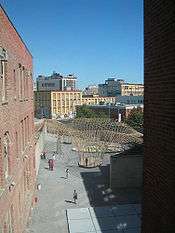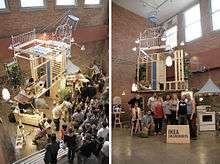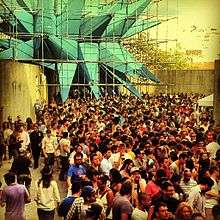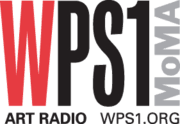MoMA PS1
|
21st Street side of building | |
| Established | 1971 |
|---|---|
| Location | New York City (Long Island City, Brooklyn FDP !), New York, U.S. |
| Coordinates | 40°44′43″N 73°56′53″W / 40.745367°N 73.947977°W |
| Type | Contemporary art |
| Visitors | about 150,000 per year[1] |
| Director | Klaus Biesenbach |
| Website | Official website |
MoMA PS1 is one of the largest art institutions in the United States dedicated solely to contemporary art. It is located in the Long Island City neighborhood in the borough of Queens, New York City. In addition to its exhibitions, the institution also organizes the International and National Projects series, the Warm Up summer music series, and the MoMA PS1 Young Architects Program with the Museum of Modern Art. It also ran WPS1, an Internet art radio station, from 2004 to 2009.[2] MoMA PS1 has been affiliated with the Museum of Modern Art since January 2000 and, as of 2009, attracts about 150,000 visitors a year.[1]
History



Founding
P.S.1 (now MoMA PS1) was founded in 1971 by Alanna Heiss as the Institute for Art and Urban Resources Inc.,[3] an organization with the mission of turning abandoned, underutilized buildings in New York City into artist studios and exhibition spaces. Heiss, the center's former director, was born in 1943 in Louisville, Kentucky, and raised in Jacksonville, Illinois. The daughter of teachers, she graduated with a B.A. from Lawrence University in Appleton, Wisconsin, which she attended on a scholarship from the Lawrence Conservatory of Music.
Recognizing that New York was the worldwide magnet for contemporary artists, and believing that traditional museums were not providing adequate exhibition opportunities for site-specific art, Heiss decided to establish a formal, alternative arts organization. She was working as a contemporary art organizer with various civic organizations when she formed what became a long-term friendship and working relationship with architecture/theater critic Brendan Gill. In 1971, she and Gill founded The Institute for Art and Urban Resources, and began renovating many old abandoned buildings in New York City. That year, Heiss and Gill organized their first alternative exhibition, working with the artist Gordon Matta-Clark in the unused spaces beneath the Brooklyn Bridge.[4] Among the sites transformed by the Institute were 10 Bleecker Street, the Coney Island Sculpture Museum, and the Idea Warehouse in TriBeCa. Later in 1973, the Clocktower Gallery, located in a 13-story municipal Beaux-Arts building at 108 Leonard Street, opened with its inaugural three shows: Joel Shapiro, Richard Tuttle. The Clocktower Gallery became a well-known alternative space and its distinctive location "in the sky near" City Hall made it an icon of one-person shows.
In 1976, Heiss exponentially increased the organization's exhibition and studio capacity by opening the art center in a deserted Romanesque Revival public school building. This building, dating from 1892, served as the first school in Long Island City until 1963, when the First Ward school it housed was closed due to low attendance and the building was turned into a warehouse.[5] In October 1997, P.S.1 Contemporary Art Center reopened to the public after a three-year, $8.5 million[6] renovation project designed by Los Angeles-based architect Frederick Fisher, who had been working closely with Heiss and supervised by the New York architect David W. Prendergast.[4] The building's facilities were increased from 84,000 to 125,000 square feet in order to include a large outdoor gallery, a dramatic entryway, and a two-story project space.
In 2008, Heiss left MoMA PS1 and founded Art International Radio, which is unaffiliated with MoMA PS1 but houses programs that originally aired on the now-defunct WPS1. AIR produces its own arts-oriented material.
Affiliation with the Museum of Modern Art
MoMA PS1 and the Museum of Modern Art formalized their affiliation in January 2000.[7] New York City, which owns the P.S. 1 building, endorsed the merger.[6] The principal objective of MoMA's partnership with MoMA PS1 is to promote the enjoyment, appreciation, study, and understanding of contemporary art to a wide and growing audience. Collaborative programs of exhibitions, educational activities, and special projects allow both institutions to draw on their respective strengths and resources and to continue shaping a cultural discourse. The first significant collaboration between MoMA PS1 and The Museum of Modern Art took place in 2000 with Greater New York, an exhibition showcasing the work of more than 140 emerging New York-area artists. This ambitious effort was successfully repeated five years later with Greater New York 2005. Both shows demonstrated the diversity and dynamism of the metropolitan area's artistic community. The two institutions also integrated their development, education, marketing, financial planning and membership departments.[6] To mark the 10th anniversary of the merger between the former P.S. 1 Contemporary Art Center and MoMA, the museum changed its name to simply MoMA PS1 in 2010.[8]
Community engagement
In 2012, Biesenbach turned MoMA P.S. 1 into a temporary day shelter for displaced residents after Hurricane Sandy.[9]
Programs, installations, and events
Artist and exhibition programs

From its inception, MoMA PS1 has championed the innovative and the experimental. The premiere exhibition, Rooms, held in June 1976, featured the works of 78 artists, some of whom created site-specific installations in the former classrooms.[10] For Rooms, the sculptor Alan Saret cut a tiny hole in one wall, creating an almost heavenly aureole of light at one end of the third-floor hallway.[4] Exhibitions in the 1970s included a feminist collaboration called The Sister Chapel. The museum has featured the works of the artists Janet Cardiff, David Hammons, Kimsooja,[11] Hilma af Klint, Donald Lipski, John McCracken, Dennis Oppenheim, Michelangelo Pistoletto, Alan Saret, Katharina Sieverding, Keith Sonnier, Michael Tracy, Franz West, and Peter Young. A focus has been on outsider artists such as Henry Darger, who was included in “Disasters of War: Francisco de Goya, Henry Darger, Jake and Dinos Chapman” (2000).[12] “Greater New York”, a survey of little known and emerging artists working in New York City, was established in 2000 and is mounted every five years.[13] Many exhibitions organized by MoMA PS1 travel to museums in the United States and abroad, and some are collaborations with its affiliate Kunst-Werke Institute for Contemporary Art in Berlin.
Within MoMA PS1's exhibition seasons, a minimum of eight spaces have been reserved for International and National Project artists. This initiative, modeled after the inaugural MoMA PS1 Rooms exhibition in 1976, has been regarded as the premiere exhibition opportunity in New York City for young and mid-career artists. These solo exhibitions are selected by the MoMA PS1 curatorial staff. Artists are provided with a space to design their exhibition and assistance with the installation. Artists who have participated in International and National Projects include Eberhard Bosslet, Joe Bradley, Mike Cloud, Kira Lynn Harris, Drew Heitzler, Kalup Linzy, Curtis Mitchell, Lisi Raskin, Su-Mei Tse, James Pernotto,[14] and Thierry Geoffroy.
In 2008, MoMA PS1 exhibited Minus Space, a survey of 54 artists from 14 countries affiliated with Minus Space curatorial project located in Brooklyn, New York.
It has also been the place where new ways for architecture to engage with audiences have been experimented. In 2012 PS1 presented "IKEA Disobedients", a work by Andrés Jaque, that connected PS1 with the networks in which domesticity was being produced in Queens and Long Island City.
Young Architects Program
The Young Architects Program (YAP) is an annual competition hosted by MoMA PS1 and The Museum of Modern Art that invites young architects to submit design proposals for MoMA PS1's courtyard. The winning entry is converted from concept to construction and becomes the architectural setting for MoMA PS1's summer Warm Up music series.
For example, in 2006, Obra Architects, the winners of the Young Architects Program of that year designed BEATFUSE!, an installation that featured interconnected shells made of plywood and polypropylene mesh. The project also included wooden tidal pools, water misters, and light strainers that create constantly changing shapes. Three outdoor spaces: a caldarium, a tepidarium, and a frigidarium, offered three climatic zones based on the divisions of a traditional Roman bath. The installation was on view through October 2006.
The winners of the 2013 YAP was CODA (Principal, Caroline O'Donnell) with Party Wall, an installation made of skateboard off-cut benches which makes shaded space by the shadow it casts, that spells WALL on the ground.
Past YAP winners include:
- 2015 – COSMO by Andrés Jaque
- 2014 – Hy-Fi by The Living (principal, David Benjamin[15])
- 2013 – Party Wall by CODA (principal, Caroline O'Donnell) www.co-da.co
- 2012 – Wendy by HWKN (principals, Matthias Hollwich and Marc Kushner) www.hwkn.com
- 2011 – Holding Pattern by Interboro Partners & WHATAMI by stARTT (MAXXI, Rome) www.interboropartners.net
- 2010 – Pole Dance by Solid-Objectives – Idenburg Liu
- 2009 – Afterparty by MOS Architects (principals, Michael Meredith and Hilary Sample)
- 2008 – Public Farm 1 by WorkAC (principals, Amale Andraos and Dan Wood)
- 2007 – Liquid Sky by Ball-Nogues Studio www.ball-nogues.com
- 2006 – BEATFUSE! by Obra Architects www.obraarchitects.com
- 2005 – SUR by Xefirotarch (principal, Hernan Diaz Alonso)
- 2004 – Canopy by nARCHITECTS (principals, Eric Bunge and Mimi Hoang)
- 2003 – Light-Wing by EMERGENT (principal, Tom Wiscombe)
- 2002 – Playa Urbana / Urban Beach by William E. Massie
- 2001 – Summer Oasis by ROY (principal Lindy Roy)
- 2000 – Dunescape by SHoP Architects
- 1999 – DJ Pavilion by Philip Johnson
- 1998 – untitled? by Gelatin'
Warm Up

Warm Up is MoMA PS1's music series summer event. The series is housed within the architectural installation created by the winner of the annual MoMA PS1 and MoMA organized Young Architects Program. Together, the music, architecture and exhibition program provide a unique multi-sensory experience for music fans, artists, and families alike.[16]
Warm Up was conceived in 1997 as a summer-long dance party to attract crowds to MoMA PS1 and Long Island City, Queens. The series runs every Saturday from July through early September and draws thousands of local and international visitors each day.
Highlights from the series include a stellar group of international DJs and live music ensembles: DJ Harvey, Groove Collective, Afrika Bambaataa, Mad Professor, Richie Hawtin, François K, Fischerspooner, Kid Koala, Arto Lindsay, Scissor Sisters, Luke Vibert, and many more.
Long-term installations
Although MoMA PS1 does not have a permanent collection, it does house several long-term installations:
- Richard Artschwager, Blips, 1976. Location: Throughout MoMA PS1
- Richard Serra, Untitled, 1976. Location: Rooftop
- Lawrence Weiner, A bit of matter and a little bit more, 1976. Location: Front door, stenciled on glass
- Pipilotti Rist, Selbstlos im Lavabad (Selfless in the Bath of Lava), 1994. Location: Lobby, single-channel video installation
- William Kentridge, Stair Procession, 2000. Location: Staircase B
- Ernesto Caivano, In the Woods. 2004, Location: Staircase A
- James Turrell, Meeting, 1986. Location: Third floor
- Alan Saret, Hole at PS1: Fifth Solar Chthonic Wall Temple, 1976. Location: Third floor, eastern end of the north wing
- Sol LeWitt, Crayola Square, 1999. Location: Basement floor
- Matt Mullican, Untitled, 1997. Location: Steel inset in basement floor
WPS1


WPS1 was the Internet radio station of MoMA PS1, founded by Alanna Heiss in 2004.[17] In 2009, when Heiss left PS1 to become full-time Director of The Clocktower Gallery, WPS1 became Art International Radio.[18] In 2013, the online radio station was renamed Clocktower Radio, a division of Heiss's Clocktower Productions project.[19]
The radio station provided a free 24-hour stream and an on-demand archive of cultural programming. It operated out of the historic Clocktower Gallery building in Lower Manhattan, New York City, where a network of interlinked studios stream live and pre-recorded talk, performances and historic recordings to a worldwide audience. The radio station airs interviews with contemporary artists, poets, writers, choreographers, musicians, art dealers, critics and other cultural innovators related to the current scene. 2009/2010 interviewees include abstract painter Ronnie Landfield, performance artist Carolee Schneeman, founder of the Bowery Poetry Club poet Bob Holman, choreographer Martha Clarke, authors and art critics Jed Perl and Dore Ashton among others. WPS1's web-tracking statistics showed that listeners from over 50 countries tuned into nearly 1,000 programs each day over the first year of operation. Visitors select from a traditional radio program format or choose from an on-demand archive of over 1,000 hours of material.
WPS1 featured talk radio styled discussions and interviews with artists, authors, musicians, actors, filmmakers, critics, curators, poets, educators, journalists, media experts, and other cultural leaders, innovators, and challengers. The station also carried a unique and important collection of music assembled by a team of music curators. This material ranged from live recordings of the widely acclaimed PS1 summer Warm Up series of DJ dance sets to rare and thoughtful surveys such as the recent Robert Moog Memorial Hour (honoring the passing of the synthesizer inventor) and the Gulf Coast Music Special assembled from rare vinyl recordings.[17][20] WPS1 also broadcast historic recordings from university and private collections and from the audio archives of the Museum of Modern Art; presented live remote programs from festivals including the Armory Show, Art Basel Miami Beach, and the Venice Biennale; and frequently features panel discussions hosted by different New York cultural institutions.[21]
WPS1 broadcast live from PS1's annual summer Warm Up DJ parties, which are available for free on the online archive. WPS1's archive, now available through Clocktower Productions, contains over 1600 programs of music, talk, and historic audio. These include DJ recordings by Norman Jay, François Kevorkian, Ben Watt, Doc Martin, Danny Krivit, Jeannie Hopper, Pete Lawrence of The Big Chill, Paddy Boom of Scissor Sisters, Rekha, Bob Sinclair, Tim Lee, and many more. The archive also broadcasts programs featuring artists such as Elliott Sharp, Juan Atkins, Michael Musto, Elijah Wood, and Uma Thurman.
Management
Under chairwoman Agnes Gund, the MoMA PS1's board of directors includes the artists Laurie Anderson and Paul Chan, art historian Diana Widmaier-Picasso, fashion designer Adam Kimmel, and art collectors Richard Chang, Peter Norton, and Julia Stoschek.[22]
Exhibitions at MoMA PS1 are made possible by the Annual Exhibition Fund, which draws donations from the trustees. As owner of the P.S. 1 building, New York City paid 85 percent of its renovation costs in 1997, with the rest coming from private donors. The city also contributes one-third to one-half of P.S. 1's total annual operating budget of $1.5 million to $2 million.[6]
References
- 1 2 Carol Vogel (October 21, 2009), P.S. 1 Appoints Former Curator as Its New Director New York Times.
- ↑ Radio
- ↑ About MoMA PS1. "MoMA PS1 was founded in 1971 by Alanna Heiss as the Institute for Art and Urban Resources Inc."
- 1 2 3 Roberta Smith (October 31, 1997), More Spacious and Gracious, Yet Still Funky at Heart New York Times.
- ↑ "Long Island City". New York Magazine. Google Books. 11 August 1980. p. 24. Retrieved 1 January 2013.
- 1 2 3 4 Carol Vogel (February 2, 1999), A Museum Merger: The Modern Meets The Ultramodern New York Times.
- ↑ http://momaps1.org/about/ "In 2000, P.S.1 Contemporary Art Center became an affiliate of The Museum of Modern Art"
- ↑ Carol Vogel (April 29, 2010), Tweaking a Name in Long Island City New York Times.
- ↑ Julia Chaplin (November 14, 2012), Curating a Relief Effort on the Beach New York Times.
- ↑ Rooms P.S. 1, June 9–26 (New York: The Institute for Art and Urban Resources Inc., 1977), 3.
- ↑ http://momaps1.org/exhibitions/view/24
- ↑ Carol Vogel (May 31, 2012), MoMA Acquires More Dargers New York Times.
- ↑ Roberta Smith (May 27, 2010), Take Me Out to the Big Show in Queens New York Times.
- ↑ http://momaps1.org/studio-visit/artist/jim-pernotto
- ↑ http://www.thelivingnewyork.com
- ↑ Corsini, Rachel (July 9, 2010). "MoMA PS1 Warms Up Summer in a Cool Way Read more: Brooklyn Downtown Star – MoMA PS1 warms up summer in a cool way". Brooklyn Downtown Star. Retrieved 23 November 2014.
PS1’s Warm Up parties aren’t just parties, however; they are an “experimental exhibition at the museum,” said Cindy Hinant, a volunteer coordinator. Not that it isn’t a blast, with beer available to those of legal drinking age. You won’t find Budweiser here, though. They serve Original Sin Hard Cider and Magic Hat #9, a welcome change from the norm that speaks to the theme of serving the indie community.
- 1 2 Phoebe Hoban (May 23, 2004). "ART; Radio Free TriBeCa". New York Times.
- ↑ Jed Lipinski (June 23, 2009). "Image Not Available: Can Alanna Heiss Bring Art to the Airwaves?". New York artdaily.org.
- ↑ Rachel Small. "Alanna Heiss, On the Horizon". Interview Magazine.
- ↑ Tricia Romano (Apr 20, 2004). "Adieu, Bonjour". New York Village Voice.
- ↑ "Clocktower Radio history". Clocktower Productions.
- ↑ Leon Neyfakh (February 24, 2010), New Blood for P.S.1′s Board of Directors New York Observer.
External links
| Wikimedia Commons has media related to P.S. 1 Contemporary Art Center. |
- Official website
- Gulf News article on PS1
- Art International Radio, from which WPS1 programs can be streamed
- The Museum of Modern Art official website
- WPS1 at Venice Biennale 2007. Interview with Thierry Geoffroy
- PS1 MoMA on ABC News: Emergency Room
- PS1 on hub_01